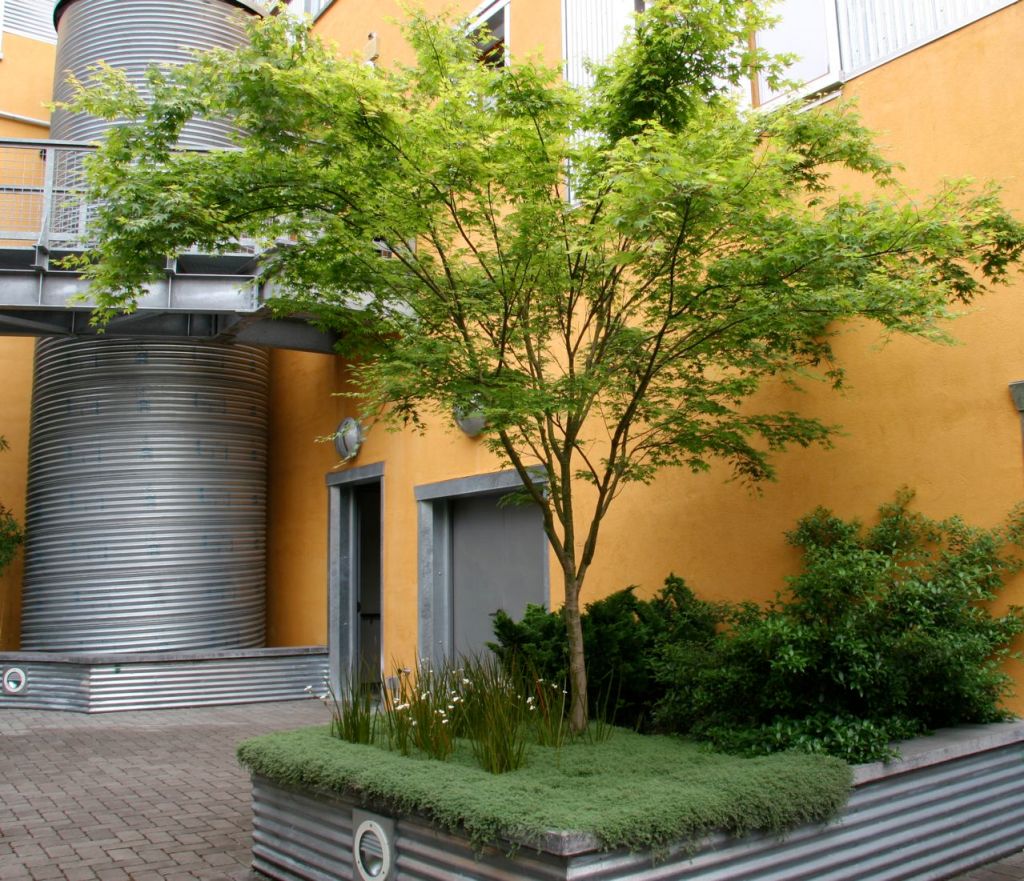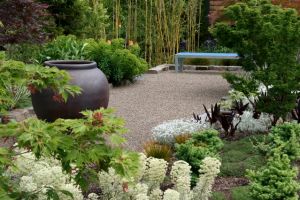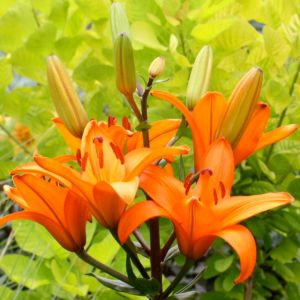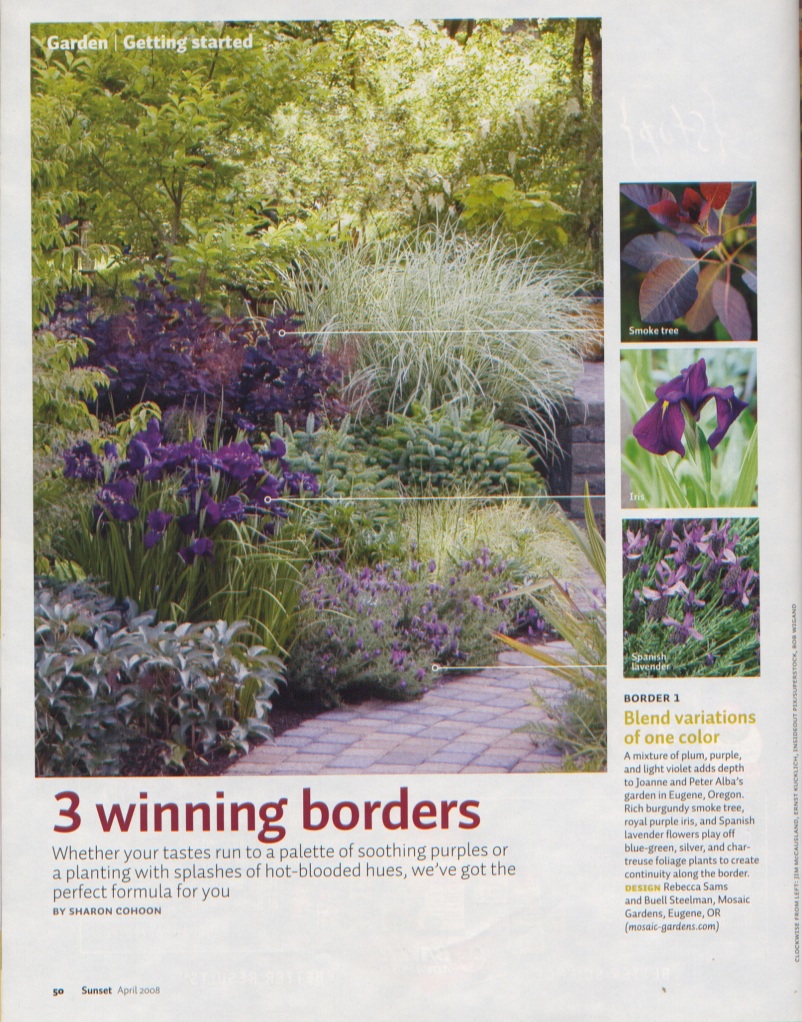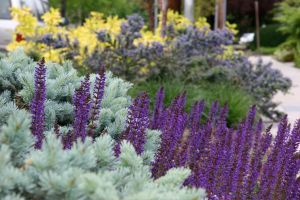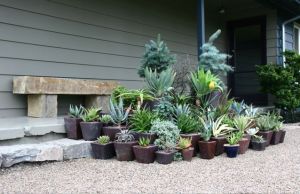New Photos of Watershed - The Exception That Proves the Rule
The Watershed is a mixed-use commercial/residential building and a rare exception to our residential garden focus. We can't say enough good things about the structure (green materials, local artisans, just fantastic inside and out), and we couldn't be more grateful for the trust that the owners had in allowing us to design and plant their garden. The plantings at ground level and on each of the many terraces are diverse, super resilient, and require very little water from the rainwater catchment system. We think that the courtyard and rusting metal water feature are a strong, grounding center to an unusual, beautiful space. Buell took a few new shots of the garden yesterday, and we'd love to know what you think!
(More info on the July 9 Open Garden coming soon!)
Japanese Maple Sale at Baltzer's!
We've got so much good news for gardeners these days! Our friends Bob and Nancy Baltzer, of Baltzer's Specialized Nursery are having a sale on their gorgeous specimen maples. All non lace leaf maples in 20 gallon or larger containers are on sale for at least $25 off and some are marked down to $75! Bob and Nancy grow a wider variety of maples than anyone we know, and they care for them beautifully. Aside from maples, the Baltzers also carry wonderful, unusual conifers and some interesting garden features. Their nursery is one of our area's little known treasures, and well worth the short drive to Pleasant Hill.
Baltzer's is open Friday - Monday, 10am - 5pm (closed Tuesday-Thursday)
36011 Highway 58 Pleasant Hill, OR 97455 541-747-5604
The Plant Sales Are Coming!
 It's that magical time of year again, when the best specialty nurseries in Oregon flock to Eugene for a one-day plant extravaganza.... On May, 7, grab your mom for a Mother's Day Eve outing and find your new favorite plants!
It's that magical time of year again, when the best specialty nurseries in Oregon flock to Eugene for a one-day plant extravaganza.... On May, 7, grab your mom for a Mother's Day Eve outing and find your new favorite plants!
The Willamette Valley Hardy Plant Group sale is in the Auditorium Building of the Lane County Fairgrounds from 9am-2pm. More information here.
The Avid Gardeners Plant Sale is also 9am-2pm (where to go first?!?) at Alton Baker Park. More information here and on their cute poster at right.
Plant group members and potential members, take note - volunteers get first dibs on plants, so pitch in!
Studies in Texture at the Bancroft Garden
Our trip to Northern California was brief, but we are so glad that we made time to visit one of our favorite gardens. The Ruth Bancroft Garden in Walnut Creek, CA is a mecca for hortitexturephiles and garden lovers of all stripes. We wrote a short post about the Bancroft Garden last year, but we may not have been emphatic enough in our praise. It is magical. You should visit. Soon.
As you probably know, a sunny summer afternoon is less than ideal for photographing gardens, but Buell managed to get a number of fun shots and (we think) a few pretty darn good ones.
Enjoy!
[gallery link="file" columns="4" orderby="title"]
Bancroft Teaser
It's Succulent Day!
Buell arranged our succulent and conifer containers last night. The arrangement looks great, hunh? Finishing that arrangement feels like the beginning of summer, our garden's best season.
These little pots make a big feature at the center of our upper gravel terrace, and a strong focal point at the top of the stairs from the stock tank terrace. In many cases, we advocate using large containers to anchor your potted arrangements, but enough small containers can have a real impact. These containers range from around 6 inches to around 20 inches in height. Most of them are hand-coiled Vietnamese pots with an ash glaze, but there are a few odds and ends that we've picked up over the years.
.
..
.
For the Birds
Some of our favorite garden visitors are birds. The garden moves with their hopping, fluttering and bathing and their songs and twitters are a soundtrack for our work. Part of the fun of watching birds is that you never quite know what they'll do next. Yesterday, Buell saw a jay dive into our stock tank pond and paddle around, hop out for a moment and then do it again! Kniphofias are usually a hummingbird thing, but two years ago, waxwings mobbed our Kniphofia northiae flowers.
There are a few plants that bring birds back year after year. Many of them are well known, but here are three of our favorites that may not make the common lists.
- Sambucus - Our 'Black Beauty' flowers and fruits reliably, and is absolutely covered in waxwings when the berries are ripe.
- Eccremocarpus is a red-flowered vine that is a hummingbird magnet. We can work and watch just a few feet from the vine in our veggie garden, and the hummers are too happy to mind. If you thin the seed pods, you'll find that the vine flowers through the entire growing season (if you don't, you may find a few baby vines spread around your garden...)
- Salvia guaranitica 'Black and Blue' proves that hummingbirds aren't complete color snobs. Its deep blue flowers vibrate with hummingbirds throughout the summer. Interestingly, we've found that while newer plants will die in a hard freeze their first winter or two, established plants survived even last year's serious cold snap.
A last word on birds: our native bird populations are dwindling, particularly the species that forage on or near the ground. There are many, many reasons for this, and there are many ways to help. Planting bird-friendly gardens and using few or no pesticides (organics first, please) are a great start. As far as the birds are concerned, the more bugs the better! Another thing you can do is to bell your cat or find another way to minimize their bird kills. We love cats, but a few of they are not native to our area and the native birds have not evolved the tricks to escape their efficient hunting. We also minimize cat (and raccoon!) traffic in our garden by netting off their favorite pathways and blocking off the gaps under our fence.
Slowly but surely....
Summer is coming. While the wet, cool weather has many people wondering if the April showers will end by July, the plants are quietly preparing to surprise us in warmer days to come. I saw our first waterlily bud this weekend, and the heat-loving plants have pushed a surprising amount of growth in the last week or so. It's possible that this rainy spring will bring us a summer to remember.

ColorTextureForm - Mosaic Newsletter #8
Howdy!
We hope our last newsletter was helpful in your spring garden work. If you haven't checked in since then, we expanded on our spring cleaning theme with a little about gardening tools, ideas for growing food in busy lives and tough spaces, and tips for making a beautiful garden scene. Beyond those ideas, we've posted some neat photos, a winter post-mortem and more, so be sure to scroll through the journal when you're done.
In this newsletter, we'll discuss how we use color, texture and form to select and place plants in our gardens. The terms color, texture and form are used together so often in articles, books and lectures about planting design that they are almost cliche, but what do they mean for your planting design? Even a quick survey of online articles shows a huge variety of ideas for designing with those terms in mind. While one designer may prioritize flower color and structure, another focuses primarily on the texture and shape of leaves.
In our work, color, texture and form carry equal weight, and we have strong ideas about the best way to see and use each one. We select our plants to create a cohesive palette, sometimes subtle, sometimes high-contrast, that reflects the desired style and mood of the space. Because the possibilities are endless, and the results should reflect you and your aesthetic, we will focus on how we think about color, texture and form, leaving the nitty-gritty fun of building a palette to you.
Color
Foliage first - While flowers are fun and part of almost every garden, foliage color is the foundation of our plant color palette. We use foliage to create sweeps of color throughout the year, or at least the growing season. The colors vary from bold, contrasting spots of yellow and purple to accents of silver and burgundy to shades of green.
Know when to hold 'em - Even in a bold palette of strong, bright colors (restraint does not mean boring), restraint is key. We intentionally leave out some colors or save them for another area. If you love every color, or are the sort of person who can't leave a good plant at the nursery, try using different palettes in different areas of the garden. As you can see in the first photo, our front garden has lots of bright, hot color, while the side garden, at right, tends toward gentler pinks, blues, creams and whites.
What are we talking about here? - What we mean by "form" is the overall shape of a plant - upright, round, conical, weeping, arching, and so on. Sometimes form and texture overlap, as in spiky plants, like iris and Phormium, but for the most part, form has more to do with outline than texture.
Round, rounded, roundish - Every plant has a form, and some are stronger than others. Not all strong forms are geometric, but those are the easiest to discuss. For example, lots of plants have what we call a "roundish" form, where the outline more or less radiates around the center. Other plants have a more perfectly rounded outline. Picea sitchensis 'Papoose,' for instance, is almost spherical. A stronger form makes a stronger statement in the garden, and can be used as a structural, almost sculptural element in planting. We will shear some plants, like boxwoods and fine foliaged conifers, to tighten and perfect their form.
The dance - In many of our gardens, we select a plant with a strong form and "dance" three to seven of them through a layer of lower plantings. The repeating, usually evergreen, forms have room to shine, while the lower plantings add seasonal contrast and interest.
Another perspective
Not all designers think alike (thank goodness), and if you are seeking a different, nuanced, and perennial-savvy take on color form and texture, we highly recommend designing with plants by Piet Oudolf with Noel Kingsbury. Oudolf's sensitivity to tiny differences in, say, flower shape helps him create ever-changing, intricate, romantic plantings. What an inspiration....
That's all for now, folks! We'll be back over the coming weeks with more ideas and, everyone's favorite, new photos, so please check back soon.
Winter freeze postmortem
Oregon had quite a freeze this winter! Temperatures in most areas fell into the single digits, and the cold took its toll on our gardens. Although we certainly lost some plants, others were tougher than expected, and a few are starting to sprout from the roots only now. We suspect a few more may peek out before all is said and done. Below are just a few notes from our observations.
One of the great mysteries of gardening is how a plant can survive one place, but not another. Eucomis 'Sparkling Burgundy' is emerging vigorously in an in-town garden and a garden off of Dillard Rd, but it is completely gone in our garden. It was in a perfect, well-drained spot. We're thoroughly baffled, and planning to replant, but we'll miss the big show this summer.
All Phormium were lost. Last winter, many suffered or died due to cold, but I don't know of any that survived this year.
We love bronze Carex, although most have a shortish attractive life span, even in mild climates. This winter, we lost almost all bronze Carex in our garden and our clients gardens. One notable exception was a well established mass of C. flagillifera that survived, looking great, in a cold garden in the south hills.
Many Miscanthus (maiden grasses) took a hit, especially those in newer plantings. We're trying to find further rhyme or reason for which lived and which died, but so far have not had much success. In some cases, the failures were in a grouping of otherwise fine plants!
Most Gunnera froze back to the roots, but seem to be sprouting... slowly. Given the mature size of Gunnera, we're not sure that starting over is a bad thing.
Kniphofia were another mixed bag. K. northiae froze to the roots, but seems to be creeping back in most cases. Other varieties are hit and miss, with a higher percentage of misses among less established plants.
We had little hope for the Agapanthus in our gardens, but a few did pretty well. Agapanthus 'Storm Cloud' survived reasonably well, but 'Ellamae' was a complete loss.
Here's an interesting one - Salvia g. 'Black and Blue' does not survive most winters.... *but* the few that have managed to become established are quite alive and well this spring.
Phlomis russeliana seems a-o.k. everywhere. P. italica and P. fruticosa were knocked back pretty hard, but survived. We expect that the pretty, but tender P. lanata is lost again.
Many Ceanothus were just on the line... the ones in warmer areas made it reasonably well, while the more tender varieties suffered in the cooler hills.
Our shade plants seemed to be in great shape, overall, even those that are supposedly in the same USDA zone as sun plants that perished.
Two of our favorite evergreen shrubs, Viburnum awabuki and Trochodendron arailoides hardly missed a beat.
I don't think we lost a single clump of bamboo (mainly from the genera Phyllostachys and Fargesia).
Herbs: At least some upright rosemary seemed to weather the cold fairly well where almost all prostrate rosemary are goners. Too bad, as we prefer the prostrate for cooking! We lost our thyme, but the sage, oregano and even bay (!) survived.
Vegetables: The kale and carrots have provided us some wonderful overwintered veggies, and our garlic is going strong, but the broccoli is long gone and our cover crop of small-seeded favas are nowhere to be seen.
Of course, there are a host of plants that seemed to almost thrive this winter, but those are the notes that leap to mind. The only overall lesson that is obvious at the moment is the improved hardiness of established plants. Now, if we could only figure out how to know if it will be a hard winter.... ; )
If we think of more losses and surprising survivors worth a mention, we'll add them to this post. Of course, if you have any additions or comments, we'd love to read them!
Plant Sales - Saturday, May 8
Make a date with your mom or your best plant buddy! Eugene's two biggest, baddest plant sales are coming on May 8. Both sales will have an incredible selection of plants from fantastic nurseries. The best plants go fast, so arrive early and work fast! Click on the links for more information.
The Oregon Plant Fair, hosted by the Avid Gardeners, takes place at Alton Baker Park
The Willamette Valley Hardy Plant Sale will be held at the Lane County Fairgrounds
Sadly, this is our last chance to buy the exquisite plants grown by Hedgerows Nursery, from McMinnville. David and Susie are moving "back east," and will be sorely missed. They have provided us with some of the best, boldest and weirdest plants in our garden. They'll have a table at the WVHPG sale but you'll have to arrive early to get the best selection....
Arizona Spring
Our friends, David and Ginger Starck just sent pictures of their young "winter" garden in Yuma and some beautiful desert wildflowers, and we thought we'd share! Gorgeous, hunh? [gallery link="file" order="DESC" columns="4"]
These two are great gardeners.... Their wonderful, rambling "summer" garden near Creswell deserves a post of its own - maybe this summer when we're all wishing our garden were as cool and shady as theirs. For now, you can get a taste here (and if anyone can find a link to the terrific Oregonian article, please send it!).
Hellebore Open Garden Days at Northwest Garden Nursery
Our friends at Northwest Garden Nursery are holding their annual Open Garden and plant sale! This wonderful little nursery and its big display garden are only open to the public only a few days a year. Ernie and Marietta O'Byrne have spent years developing the most gorgeous strains of Hellebores, with attention to the tiniest details of foliage and flower, and working in their inspiring display garden. The garden is full of rare and wonderful plants, combined with an eye for subtle, but striking combinations of color and foliage texture.
Helleborus orientalis and related hybrids are a mainstay of our plantings. Their glossy, dark, evergreen foliage enriches shady to partial sun plantings, even those that are heavily browsed by deer. We love to plant them in groups of 7 to 40, contrasted against a block of lighter or silver foliaged plants, such as Brunnera 'Jack Frost.' Their foliage alone would be good enough for us, but the stunning flowers are a magical addition to the late winter garden. Caring for Hellebores couldn't be easier. In winter, before or just as the flowers emerge, cut off the old leaves. When the flowers start to fade and set seed, cut off the whole flower stalk (with any leaves directly attached to it), leaving the new leaves that emerged after the flowers. These two simple steps will keep your Hellebore patch healthy, full and happy for years to come!
Make a date to visit Northwest Garden Nursery with your best plant buddy in the next few weeks, and start or add to your Hellebore collection.
Northwest Garden Nursery's Hellebore Garden Open Days for 2010 are:
- Saturday and Sunday, February 20 and 21
- Saturday and Sunday, February 27 and 28
- Friday, Saturday and Sunday, March 5-7
Beginning March 11 they are open regular hours on Thursdays, Fridays and Saturdays from 10:00 a.m. to 5:00 p.m. through the end of March (March 27).
Click here for directions and a map to the nursery.
Mosaic Q&A - Sunset April 2008 Border
Have a question? Want more frequent updates? We’d love to hear from you! Read more here and/or write us in the comments or at mosaic@mosaic-gardens.com.
A question from colder climes:
I cannot tell you what an inspiration the border [featured in the April 08 Sunset] has been for me! I am writing you to find out what the other plants are besides those listed in the article. I live in Northeast Wyoming do I imagine some will not work in our zone, but I will try to find similar color or texture matches for our garden.
Thanks! We've included a scan of the article and a plant list below. While some of the plants shown are not hardy in a cold climate, your inclination to focus on texture and color will definitely help you create your own striking border. When designing with plants, we focus on creating a palette, rather than a plant list. In the border shown in the Sunset photo, purple, silver, cream and white create a simple color palette. The playful feeling of the border comes mainly from the contrast of foliage texture - big Hellebore leaves, arching grasses, spiky iris, soft lavenders - while the spherical forms of dwarf Sitka spruce anchor the space through all seasons. One final idea worth noting is that we used small groupings of plants to create waves of foliage, rather than a jumble of individual specimens. This simplifies the visual effect, as well as the maintenance!
Sunset April '08 photo plant list (all deer resistant in our area):
Helleborus x sternii Iris sibirica (not sure which variety, b/c so many are similar) Cotinus 'Royal Purple' Lavandula stoechas Picea sitchensis 'Papoose' Carex m 'Aureovariegata' Miscanthus s. 'Variegata'
We very much enjoy hearing from you, and we look forward to more questions!
Mosaic Q&A - Picea pungens 'Globosa Nana' and other dwarf forms
[Edit: Hi! This page gets a lot of traffic, so we thought we'd make sure you knew about the rest of our journal . We update regularly during the growing season and hope you'll check back in. Thanks for stopping by! Mosaic]
A journal reader from California had a question about the "gray/silver plant in the left foreground" of the photo at left. The photo originally appeared in Newsletter #4, in which we discussed how to create lower maintenance gardens. The plant is Picea pungens 'Globosa Nana,' a dwarf form of the Colorado Blue Spruce, and it is a soft-looking, deer resistant, drought tolerant, low-maintenance all star. We use a variety of Picea pungens dwarfs, whose silver to blue color and compact, rounded forms add form, color and texture to our gardens throughout the year. We will use single large specimens or let three to seven pungens dwarfs dance through lower plantings. Below is a gallery of Picea pungens at work in our gardens - click for larger images.
Thanks for the question! Look forward to reading more!
1
[gallery link="file" columns="4" orderby="rand"]
.
Baja Inspiration
On the advice of Rebecca's wise, artist mother, we will not try to contain the sights and experiences of our trip to central Baja in words. We do hope we can share a bit of inspiration through the gallery below. Just click on the photos for a closer look.
Just two observations:
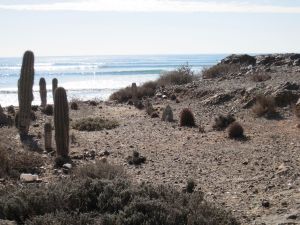 1) Gardeners are everywhere. In dry, windswept, rocky terrain, miles from the nearest asphalt or basic services, people built stone borders and walls and transplanted and cared for native plants. Some were creations of visiting "gringos," like the river rock garden in the gallery, but most were built by locals. The photo at left, while far from the best of our shots, shows a small garden near a fish camp on the Pacific coast. The buildings in the fish camp had no plumbing, electricity, or even windows, beyond a hole in the wall, but the handful of fishermen had cultivated a handful of striking plants, collected from inland hills, along a path to the bay.
1) Gardeners are everywhere. In dry, windswept, rocky terrain, miles from the nearest asphalt or basic services, people built stone borders and walls and transplanted and cared for native plants. Some were creations of visiting "gringos," like the river rock garden in the gallery, but most were built by locals. The photo at left, while far from the best of our shots, shows a small garden near a fish camp on the Pacific coast. The buildings in the fish camp had no plumbing, electricity, or even windows, beyond a hole in the wall, but the handful of fishermen had cultivated a handful of striking plants, collected from inland hills, along a path to the bay.
2) A good time was had by all.
i
i
[gallery columns="5"]
Grateful for Gosslers
 Thanksgiving is our favorite holiday for many reasons, from time with loved ones to mountains of mashed potatoes. In addition to our gratitude for our foundation of good health, family and friends, we are thankful for our creative, trying, engaging, intricate, brute force, dirty, rewarding, nitpicky, joyful work of building gardens. So many people, from our wonderful clients to the nice folks who deliver our soil, make Mosaic possible. In honor of the season, we'd like to highlight one nursery that has been a source of support, information and, of course, plants since we started planting in Oregon.
Thanksgiving is our favorite holiday for many reasons, from time with loved ones to mountains of mashed potatoes. In addition to our gratitude for our foundation of good health, family and friends, we are thankful for our creative, trying, engaging, intricate, brute force, dirty, rewarding, nitpicky, joyful work of building gardens. So many people, from our wonderful clients to the nice folks who deliver our soil, make Mosaic possible. In honor of the season, we'd like to highlight one nursery that has been a source of support, information and, of course, plants since we started planting in Oregon.
Roger, Marj and Eric of Gossler Farms Nursery are Renaissance plantspeople. They know something about almost every plant we can grow in the PNW, (as well as quite a few that we cannot), and they have forgotten more than most of us will ever know about Magnolias and deciduous shrubs. We discover new plants every time we walk through their greenhouses, and rely heavily on their detailed knowledge of each variety's habits and cultivation. Thanks to their mail order prowess, they've even selected and shipped plants to our mothers on the East Coast (Hi Moms!). Our moms were thrilled and the plants are still thriving.
If that weren't enough, they've now published a beautiful book, The Gossler Guide to the Best Hardy Shrubs, which features well-researched, insightful, amusing text, terrific photos, and one of our absolute favorite plants. This plant is gorgeous, rare, and an absolute showstopper throughout the growing season. Intrigued? You can buy a copy online, or better yet, get a signed copy and some personalized advice at the nursery. The plant is discussed and beautifully photographed on pages 58-61.
We hope you'll take the time to read the book, stroll through the nursery, or order a couple of plants for your mom. If nothing else, don't forget to thank the Gosslers and other great plantspeople for sharing their passion and knowledge with all of us.
Last, but not least, thanks so much for keeping up with us. As you may have noticed, our journal writing has slowed down this fall We're taking a much-needed break right now, but will return in a few weeks with an idea that we hope will keep the journal moving through the shorter days.
Best, Rebecca & Buell
Allium
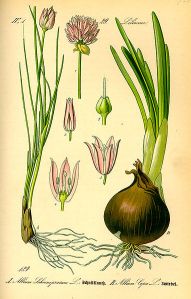 For those of you who are already (or always) thinking about next year's garden, there's still time to plant Allium bulbs - ornamental relatives of onions and garlic - in your sunny beds. The flowers of the most common ornamental Alliums are a whimsical, spherical burst of pink, lavender or white at the top of a tall stalk, but there are low varieties with gorgeous foliage, as well as bizarre starburst and hairy flowers for those of us who can never have enough weird plants. Alliums show their stuff right after the big spring show and before the summer flowers are in full swing.
For those of you who are already (or always) thinking about next year's garden, there's still time to plant Allium bulbs - ornamental relatives of onions and garlic - in your sunny beds. The flowers of the most common ornamental Alliums are a whimsical, spherical burst of pink, lavender or white at the top of a tall stalk, but there are low varieties with gorgeous foliage, as well as bizarre starburst and hairy flowers for those of us who can never have enough weird plants. Alliums show their stuff right after the big spring show and before the summer flowers are in full swing.
We love to tuck Allium bulbs in small spaces between plants. You only notice them at their best, and they seem to disappear after they are deadheaded. A dozen or more look terrific sweeping above and through lower plantings.
If that's not enough to inspire you, Alliums are deer resistant, drought tolerant and make great cut fresh or dried floral arrangements. Cool!
Take a moment to gain a little additional inspiration from the Google images pages, and add a few Alliums to your fall garden to-do list!
The Ruth Bancroft Garden
The Ruth Bancroft Garden in Walnut Creek, CA is a wonderland of textures and colors, and a stunning example of why we would move to Northern CA, if we could only convince a few million people to move away. How lucky that one of the best collections of succulents anywhere would be so beautifully curated.... We hope you'll find time to visit when you're in the Bay Area. It's one of our favorite places, and it may become one of yours, as well. Be sure to check out their photo pages!
WARNING: Visiting the Bancroft Garden can be a thorny proposition for those of us with an affection for spiky, spiny, sculptural plants. They have a nursery, and if you are like us, there is always room for one (or twelve) more little containers.... Serious succulent addicts should be sure to avoid the Dry Garden in Oakland, unless they are prepared to build a cold frame.
Just a thought.... The Bancroft Garden is one of the Garden Conservancy's Preservation Projects, and one very good reason to join the Conservancy (or give/request a gift membership). 






